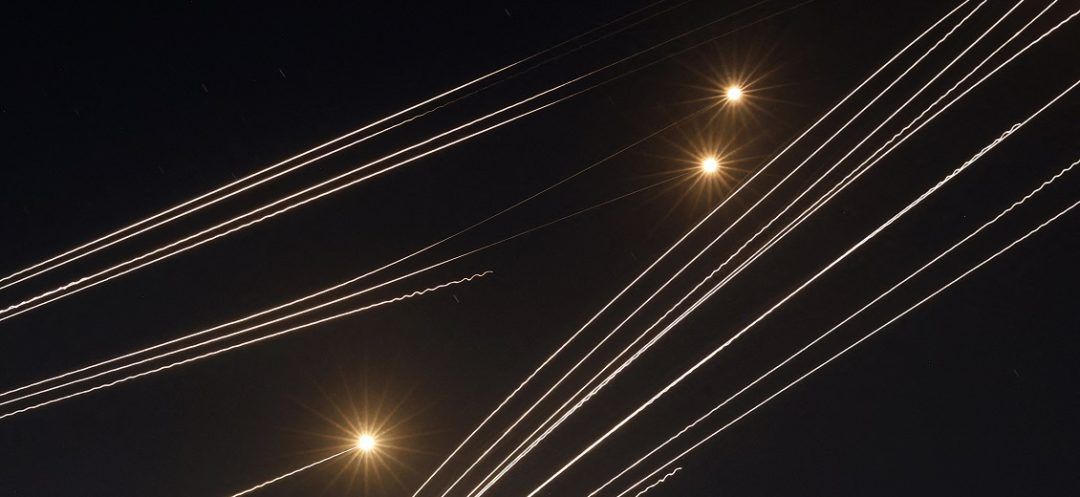- Home
- War in the Middle East
- Zoom in on Hezbollah's Fadi Rockets

©(FILES) Rockets fired from southern Lebanon are intercepted by Israel's Iron Dome air defense system in the Upper Galilee region of northern Israel on August 4, 2024, as cross-border clashes continue between Israeli troops and Lebanese Hezbollah fighters. (Photo Jalaa MAREY / AFP)
Hezbollah claimed on Sunday that it had targeted Israeli military production facilities and an airbase in the Haifa region in response to the deadly explosions that hit its communications equipment earlier this week. Notably, the pro-Iranian group revealed that it had used projectiles for the first time since October 8: the Fadi-1 and Fadi-2 ground-to-ground rockets.
According to al-Mayadeen, the rockets are named after Fadi Hassan Tawil, a Hezbollah leader born in 1969 in Beirut, who died in 1987 while fighting Israeli forces during their occupation of Lebanon. His brother, Wissam Tawil, a commander of Hezbollah’s elite al-Radwan force, was also killed on January 8 in ongoing clashes along the Lebanese-Israeli border, which have continued since 8 October.
According to Hezbollah propaganda videos, the Fadi-1 rocket has a caliber of 220 mm, is 6 meters long and is equipped with an 83-kilogram explosive warhead. It is typically launched from a vehicle-mounted multiple rocket launcher, with a range of up to 70 kilometers.
The larger Fadi-2 is similar in size but has a 302 mm caliber and carries a more powerful 170-kilogram explosive charge, with a range reportedly exceeding 100 kilometers. Both projectiles are described as unguided by the pro-Iranian group.
These ranges therefore enable them to target areas beyond the border zone, while launching the rockets from deep within Lebanese territory, which would explain their use against Haifa. Hezbollah reportedly had used these rockets previously during the 2006 war.
According to media sources affiliated with Hezbollah, the rockets launched on Sunday morning were fired from the infamous "Imad-4" underground network, which is believed to house multiple rocket launchers.
While Hezbollah had mainly relied on short-range rockets, such as Katyushas, the use of projectiles like the Fadi-1 and Fadi-2, which offer much greater destructive capability and range, sends a strong message: Hassan Nasrallah’s group is now ready to target deeper into Israeli territory. This move is a direct response to Israeli escalation, but it also carries the risk of further inflaming tensions.
According to al-Mayadeen, the rockets are named after Fadi Hassan Tawil, a Hezbollah leader born in 1969 in Beirut, who died in 1987 while fighting Israeli forces during their occupation of Lebanon. His brother, Wissam Tawil, a commander of Hezbollah’s elite al-Radwan force, was also killed on January 8 in ongoing clashes along the Lebanese-Israeli border, which have continued since 8 October.
According to Hezbollah propaganda videos, the Fadi-1 rocket has a caliber of 220 mm, is 6 meters long and is equipped with an 83-kilogram explosive warhead. It is typically launched from a vehicle-mounted multiple rocket launcher, with a range of up to 70 kilometers.
The larger Fadi-2 is similar in size but has a 302 mm caliber and carries a more powerful 170-kilogram explosive charge, with a range reportedly exceeding 100 kilometers. Both projectiles are described as unguided by the pro-Iranian group.
These ranges therefore enable them to target areas beyond the border zone, while launching the rockets from deep within Lebanese territory, which would explain their use against Haifa. Hezbollah reportedly had used these rockets previously during the 2006 war.
According to media sources affiliated with Hezbollah, the rockets launched on Sunday morning were fired from the infamous "Imad-4" underground network, which is believed to house multiple rocket launchers.
While Hezbollah had mainly relied on short-range rockets, such as Katyushas, the use of projectiles like the Fadi-1 and Fadi-2, which offer much greater destructive capability and range, sends a strong message: Hassan Nasrallah’s group is now ready to target deeper into Israeli territory. This move is a direct response to Israeli escalation, but it also carries the risk of further inflaming tensions.
Read more




Comments